June 23rd Scots Book of Days
June 23 Battle of Bannockburn guarantees Scotland’s freedom for two more centuries.
678 Etheldreda, Abbess of Ely.
1314 Sunday! Battle of Bannockburn. Soldiers heard mass, confessed. King 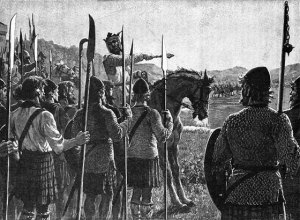 Edward detached 800 horse under Sir Robert Clifford to turn the left flank of the Scottish army, and relieve Stirling castle. Robert Bruce King of Scots saw English Army approaching Stirling. (TG10-151). “See, Randolph,” said the King Robert to his nephew, “there is a rose fallen from your chaplet.” By this the Bruce meant, that Randolph had lost some honour, by suffering the enemy to pass where he had been stationed to hinder them. Randolph puts English cavalry to flight. Clifford’s squadron was defeated. Robert de Bruce addresses his troops before the Battle of Bannockburn. http://www.britishbattles.com/scottish/battle-bannockburn.htm
Edward detached 800 horse under Sir Robert Clifford to turn the left flank of the Scottish army, and relieve Stirling castle. Robert Bruce King of Scots saw English Army approaching Stirling. (TG10-151). “See, Randolph,” said the King Robert to his nephew, “there is a rose fallen from your chaplet.” By this the Bruce meant, that Randolph had lost some honour, by suffering the enemy to pass where he had been stationed to hinder them. Randolph puts English cavalry to flight. Clifford’s squadron was defeated. Robert de Bruce addresses his troops before the Battle of Bannockburn. http://www.britishbattles.com/scottish/battle-bannockburn.htm
- Brus or Bruce 1050 2Stewart2Kennedy 2Montgomery2Blair 2Cochrane2Miller 2Simmons2Choate zoe ToaG
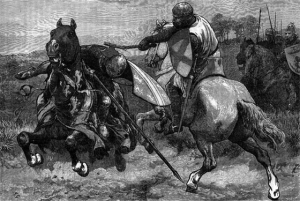 Sir Henry de Bohun charged Bruce. Henry’s iron helmet lost from a blow of the battle axe by Bruce, who remarked “I have broken my good battle-axe.” Thomas Randolph, 1st Earl of Moray, commanded the vanguard, which was stationed about a mile to the south of Stirling, near the church of St. Ninian, while the king commanded the rearguard at the entrance to the New Park. His brother, Edward, led the third division. According to Barbour, there was a 4th nominally under the youthful Walter the Steward, but actually under the command of Sir James Douglas. Both sides employed slingers and crossbowmen. Mowbray also pointed out that there was no need to force a battle, as Edward was now close enough to the castle to constitute a technical relief in terms of the agreement with Edward Bruce. But even if the king was disposed to act on Mowbray’s advice, it was already too late; for he was showing signs of losing control of his formidable but unwieldy host.
Sir Henry de Bohun charged Bruce. Henry’s iron helmet lost from a blow of the battle axe by Bruce, who remarked “I have broken my good battle-axe.” Thomas Randolph, 1st Earl of Moray, commanded the vanguard, which was stationed about a mile to the south of Stirling, near the church of St. Ninian, while the king commanded the rearguard at the entrance to the New Park. His brother, Edward, led the third division. According to Barbour, there was a 4th nominally under the youthful Walter the Steward, but actually under the command of Sir James Douglas. Both sides employed slingers and crossbowmen. Mowbray also pointed out that there was no need to force a battle, as Edward was now close enough to the castle to constitute a technical relief in terms of the agreement with Edward Bruce. But even if the king was disposed to act on Mowbray’s advice, it was already too late; for he was showing signs of losing control of his formidable but unwieldy host. 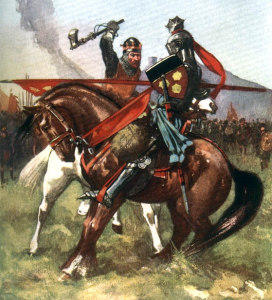 Robert de Bruce kills Sir Henry de Bohun in single
combat on the 1st day of the Battle of Bannockburn. Henry de Bohun, nephew of the Earl of Hereford, was riding ahead of his companions when he caught sight of the Scottish king. De Bohun lowered his lance and began a charge that carried him to lasting fame. King Robert was mounted on a small palfrey and armed only with a battle-axe. He had no armour on. As de Bohun’s great war-horse thundered towards him, he stood his ground, watched with mounting anxiety by his own army. With the Englishman only feet away,
Robert de Bruce kills Sir Henry de Bohun in single
combat on the 1st day of the Battle of Bannockburn. Henry de Bohun, nephew of the Earl of Hereford, was riding ahead of his companions when he caught sight of the Scottish king. De Bohun lowered his lance and began a charge that carried him to lasting fame. King Robert was mounted on a small palfrey and armed only with a battle-axe. He had no armour on. As de Bohun’s great war-horse thundered towards him, he stood his ground, watched with mounting anxiety by his own army. With the Englishman only feet away,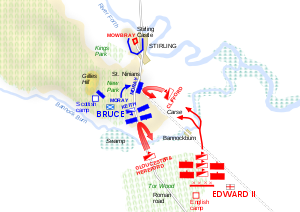 Bruce turned aside, stood in his stirrups and hit the knight so hard with his axe that he split his helmet and head in two. Robert de Bruce kills Sir Henry de Bohun, hand to hand, in your face, battle axe versus pike, King versus knight, defender versus invader.
Bruce turned aside, stood in his stirrups and hit the knight so hard with his axe that he split his helmet and head in two. Robert de Bruce kills Sir Henry de Bohun, hand to hand, in your face, battle axe versus pike, King versus knight, defender versus invader.
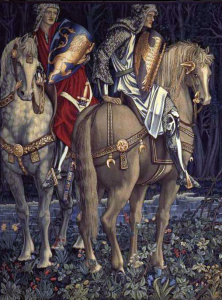 battle of Bannockburn-first day.
battle of Bannockburn-first day.
Knights of the period of the Battle of Bannockburn: picture by Edward Burne-Jones.
1429 Battle of Lochaber between the forces of Alexander of Islay, Earl of Ross, 3rd Lord of the Isles and chief of Clan Donald (Clan MacDonald),
Clan Cameron, Clan Mackintosh against the Royalist army of King James I of Scotland. Called The Battle of Split Allegiances among the Camerons.
1456 . Margaret of Denmark born. (23 June 1456 – before 14 July 1486).
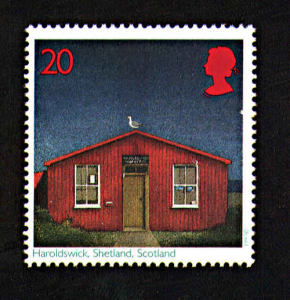 In 1468 Christian 1st pledged Shetland to pay the dowry of his daughter Margaret, betrothed to James III of Scotland. As the money was never paid, the connection with the crown of Scotland has become perpetual. In 1470 William Sinclair, 1st Earl of Caithness ceded his title to James III and the following year the Northern Isles were directly annexed to Scotland
In 1468 Christian 1st pledged Shetland to pay the dowry of his daughter Margaret, betrothed to James III of Scotland. As the money was never paid, the connection with the crown of Scotland has become perpetual. In 1470 William Sinclair, 1st Earl of Caithness ceded his title to James III and the following year the Northern Isles were directly annexed to Scotland
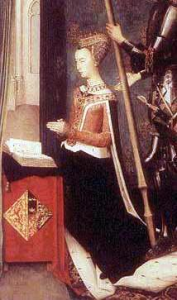 Margaret of Denmark House of Oldenburg. Queen consort of Scotland, mother of King James IV of Scotland, Margaret Oldenburg was betrothed to James of Scotland in 1460 (age 3), married age 13.
Margaret of Denmark House of Oldenburg. Queen consort of Scotland, mother of King James IV of Scotland, Margaret Oldenburg was betrothed to James of Scotland in 1460 (age 3), married age 13.
1585 the coining-house was removed to Dundee, and the Court of session was transferred to Stirling, then the mint (coining house) was moved to Perth. June 23. A History of Epidemics in Britain from A.D. 664 to the Extinction of Plague Charles Creighton, M.A. M.D. Demonstrator of Anatomy University of Cambridge. 1891
1631 Sir Duncan Campbell of Glenorchy, 1st Bt (Baronette). Died. born circa 1550. He was the son of Sir Colin Campbell of Glenorchy and Catherine Ruthven. He married by contract, firstly, Lady Jean Stewart, daughter of John Stewart, 4th Earl of Atholl and Margaret Fleming, on 18 November 1573. He married by contract, secondly, Elizabeth Sinclair, daughter of Henry Sinclair, 5th Lord Sinclair and Elizabeth Forbes, on 20 October 1597. He died on 23 June 1631. He was buried at Finlarig, Scotland.
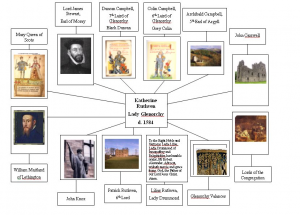 Sir Duncan Campbell of Glenorchy, 1st Bt. also went by the nick-name of ‘Black Duncan’ was invested as a Knight on 18 May 1590. Black Duncan held the office of Member of Parliament (M.P.) for Argyllshire [Scotland] in 1593 and held the office of Hereditary Sheriff of Perthshire, for life. He was created 1st Baronet Campbell, of Glenorchy, co. Perth [Nova Scotia] on 29 May 1625. He lived at Glenorchy, Argyllshire, Scotland.
Sir Duncan Campbell of Glenorchy, 1st Bt. also went by the nick-name of ‘Black Duncan’ was invested as a Knight on 18 May 1590. Black Duncan held the office of Member of Parliament (M.P.) for Argyllshire [Scotland] in 1593 and held the office of Hereditary Sheriff of Perthshire, for life. He was created 1st Baronet Campbell, of Glenorchy, co. Perth [Nova Scotia] on 29 May 1625. He lived at Glenorchy, Argyllshire, Scotland.
Campbell Earl of Argyll 1010 2Montgomery2Blair 2Cochrane2Miller 2Simmons2Choate to zoe TOAG
Katherine Ruthven page http://www2.div.ed.ac.uk/courses/Kate/
1634 Mr. Josias Welch, died. in the flower of his youth, leaving only one son behind him, viz. Mr. John Welch, who was afterward minister at Irongray in Galloway. Josias was younger son to the famous Mr. John Welch s minister of the gospel at Ayr, and Elizabeth Knox daughter to the great Mr. John Knox, who was minister at Edinburgh. Biographia Scoticana: OR, A BRIEF HISTORICAL ACCOUNT OF THE LIVES, CHARACTERS, and MEMORABLE TRANSACTIONS of the most eminent SCOTS WORTHIES, Noblemen, Gentlemen, Ministers, and others: From Mr. Patrick Hamilton, who was born about the year of our Lord 1503, and suffered martyrdom at St. Andrews, Feb. 1527, to Mr. James Renwick, who was executed in the Grass-market of Edinburgh Feb. 17, 1688. together with a succinct Account of the Lives of other seven eminent Divines, and Sir Robert Hamilton of Preston, who died about, or shortly after the Revolution.as also, An Appendix, containing a short historical Hint of the wicked Lives and miserable Deaths of some of the most remarkable apostates and bloody persecutors in Scotland from the Reformation to the Revolution. Collected from historical Records, Biographical Accounts, and other authenticated Writings: The whole including a Period of near Two Hundred Years. By John Howie – 178181
1650 Charles II signs the Solemn League and Covenant.
1707 Sir John Cochrane of Ochiltree (d after 23.06.1707) (03.1656) Margaret Strickland (dau of Sir William Strickland, 1st Bart of Boynton
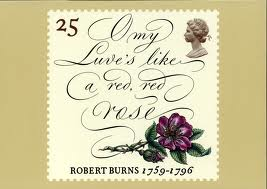 1725 – Ale tax passed for raising revenue. [TG74-11] Not well received. Because of climate and soil, Scots crops required six times the acreage for growing equivalent as compared to English, so a tax on Ale bore six times the weight in Scotland as in England.
1725 – Ale tax passed for raising revenue. [TG74-11] Not well received. Because of climate and soil, Scots crops required six times the acreage for growing equivalent as compared to English, so a tax on Ale bore six times the weight in Scotland as in England.
O my Luve’s like a red, red Rose. Robert Burns 1759-1796.
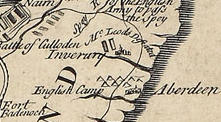 1745 June 23. TROOPS ENGAGED At the opening of hostilities, the troops then in Scotland were quartered thus: Gardiner’s Dragoons (13th H. ) at Stirling, Linlithgow, Musselburgh, Kelso, and Coldstream; Hamilton’s Dragoons (14th H.), at Haddington, Dunae, and adjacent places; horses of both regiments at grass; Guise’s Regiment (6th of Foot), at Aberdeen and out-stations;
1745 June 23. TROOPS ENGAGED At the opening of hostilities, the troops then in Scotland were quartered thus: Gardiner’s Dragoons (13th H. ) at Stirling, Linlithgow, Musselburgh, Kelso, and Coldstream; Hamilton’s Dragoons (14th H.), at Haddington, Dunae, and adjacent places; horses of both regiments at grass; Guise’s Regiment (6th of Foot), at Aberdeen and out-stations;
five companies of Lee’s (44th ), at Dumfries, Stranraer, Glasgow, and Stirling; Murray’s (46th ), in the Highland barracks; Lascel1e’s (47th ), at Edinburgh and Leith; two additional companies of the Royal Scots (1st ), at Perth; two of the Scots Fusiliers (21st ), at Glasgow; two of Sempill’s (25th ), at pg 106 [90] Cupar-Fife; three of Lord John Murrays8 Highlanders (42nd ) at Crieff; Lord Loudon’s Highland Regiment was beginning to be raised~ There
Were standing garrisons of Invalids in the castles (G.C. T. 5). Publications OF THE SCOTISH HISTORY SOCIETY VOLUME XXIII , Pg 105 [89] April 1897 SUPPLEMENT LYON IN MOURNING PRINCE CHARLES EDWARD STUART ITINERARY AND MAP. Ed.W. B. BLAIKIE, from Narrative of Lord MacLeod, son of the Earl of Cromarty.
1812 Bonaparte reaches frontier of Russia with the army, crossing the Niemen river. Bonaparte wants an immediate battle, the Russians retreat to draw the invader far from the supplies. Tytler’s Britannica.
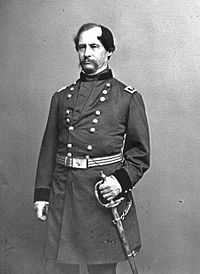 1862 General Hunter enlisted ex-slaves as soldiers in South Carolina without permission from the War Department. This incensed border state slave holders, and Kentucky Representative Charles A. Wickliffe sponsored a resolution demanding a response. Hunter wrote in reply that no regiment of “Fugitive Slaves” has been, or is being organized in this Department. There is, however, a fine regiment of persons whose late masters are “Fugitive Rebels”–men who everywhere fly before the appearance of the National Flag, leaving their servants behind them to shift as best they can for themselves. . . . So far, indeed, are the loyal persons composing this regiment from seeking to avoid the presence of their late owners, that they are now, one and all, working with remarkable industry to place themselves in a position to go in full and effective pursuit of their fugacious and traitorous proprietors. . . . the instructions given to Brig. Gen. W. T. Sherman by the Hon. Simon Cameron, late Secretary of War, and turned over to me by succession for my guidance,–do distinctly authorize me to employ all loyal persons offering their services in defence of the Union and for the suppression of this Rebellion in any manner I might see fit. . . . In conclusion I would say it is my hope,–there appearing no possibility of other reinforcements owing to the exigencies of the Campaign in the Peninsula,–to have organized by the end of next Fall, and to be able to present to the Government, from forty eight to fifty thousand of these hardy and devoted soldiers.” David Hunter (July 21, 1802 – February 2, 1886) was a Union general in the American Civil War, “Black Dave” (clan Hunter). “Black Dave”
1862 General Hunter enlisted ex-slaves as soldiers in South Carolina without permission from the War Department. This incensed border state slave holders, and Kentucky Representative Charles A. Wickliffe sponsored a resolution demanding a response. Hunter wrote in reply that no regiment of “Fugitive Slaves” has been, or is being organized in this Department. There is, however, a fine regiment of persons whose late masters are “Fugitive Rebels”–men who everywhere fly before the appearance of the National Flag, leaving their servants behind them to shift as best they can for themselves. . . . So far, indeed, are the loyal persons composing this regiment from seeking to avoid the presence of their late owners, that they are now, one and all, working with remarkable industry to place themselves in a position to go in full and effective pursuit of their fugacious and traitorous proprietors. . . . the instructions given to Brig. Gen. W. T. Sherman by the Hon. Simon Cameron, late Secretary of War, and turned over to me by succession for my guidance,–do distinctly authorize me to employ all loyal persons offering their services in defence of the Union and for the suppression of this Rebellion in any manner I might see fit. . . . In conclusion I would say it is my hope,–there appearing no possibility of other reinforcements owing to the exigencies of the Campaign in the Peninsula,–to have organized by the end of next Fall, and to be able to present to the Government, from forty eight to fifty thousand of these hardy and devoted soldiers.” David Hunter (July 21, 1802 – February 2, 1886) was a Union general in the American Civil War, “Black Dave” (clan Hunter). “Black Dave”
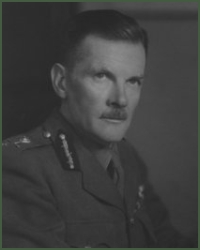 1893 Sir Rob McGregor Macdonald LOCKHART born. The Most Honourable Order of the Bath KCB The Most Eminent Order of the Indian Empire CIE The Military Cross MC. Commissioned as unattached officer, Indian Army 1913; joined 51st Sikhs Frontier Force 1914; World War I 1914-1918; World War II 1939-1945; Director of Staff Duties, India Office 1940-1943; acting Governor, North West Frontier, India, Jun-Aug 1947; Commander-in-Chief, Indian Army, Aug-Dec 1947; retired 1948; Deputy Chief Scout, Boy Scouts’ Association 1951-1961; President, Greater London Central Scout County 1965-1972. He served on the World Scout Committee of the World Organization of the Scout Movement from 1953 to 1959.
1893 Sir Rob McGregor Macdonald LOCKHART born. The Most Honourable Order of the Bath KCB The Most Eminent Order of the Indian Empire CIE The Military Cross MC. Commissioned as unattached officer, Indian Army 1913; joined 51st Sikhs Frontier Force 1914; World War I 1914-1918; World War II 1939-1945; Director of Staff Duties, India Office 1940-1943; acting Governor, North West Frontier, India, Jun-Aug 1947; Commander-in-Chief, Indian Army, Aug-Dec 1947; retired 1948; Deputy Chief Scout, Boy Scouts’ Association 1951-1961; President, Greater London Central Scout County 1965-1972. He served on the World Scout Committee of the World Organization of the Scout Movement from 1953 to 1959.
http://www.kcl.ac.uk/lhcma/locreg/LOCKHART1.shtml
General Sir Rob Lockhart, Bronze Wolf Award, the only distinction of the World Organization of the Scout Movement, awarded by the World Scout Committee for exceptional services to world Scouting, in 1961.
- Lockhart of Bar 1297 2Miller 2Simmons 2Choate 2Sorensen
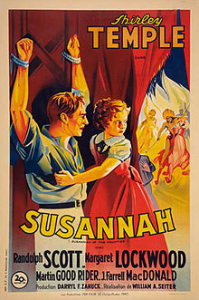 1939 Susannah of the Mounties released. Shirley Temple is orphaned in Canada, Randolph Scott is the Mountie trying to maintain peace on the frontier. Auld Lang Syne by Robert Burns is a featured song. Shirley saves the Mountie in a scene reminiscent of Pocahontas saving Captain John Smith in Jamestown in 1610. Randolph Scott is Scottish descent.
1939 Susannah of the Mounties released. Shirley Temple is orphaned in Canada, Randolph Scott is the Mountie trying to maintain peace on the frontier. Auld Lang Syne by Robert Burns is a featured song. Shirley saves the Mountie in a scene reminiscent of Pocahontas saving Captain John Smith in Jamestown in 1610. Randolph Scott is Scottish descent.
1998 THE HEART of Robert the Bruce, the great 14th-century warrior- king of Scotland, was officially laid to rest. Donald Dewar, Secretary of State for Scotland, unveiled a marker stone over the spot at 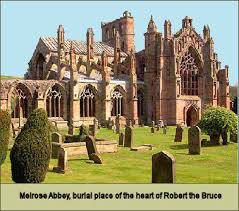 Melrose Abbey where King Robert’s heart has been reburied. The shrivelled relic, contained in an ancient casket, has been held in safekeeping in Edinburgh for the last two years following its rediscovery during an archaeological dig. 684 years to the day after Bruce dispatched the much bigger army of Edward I back to England to “think again” at the Battle of Bannockburn. The rest of Bruce’s body was destined for Dunfermline Abbey, the burial place of Scots kings. The casket containing a mummified heart was first unearthed by archaeologists in 1921. It was placed in a lead container and reburied, only to be uncovered by another set of archaeologists 75 years later. www.independent.co.uk Melrose Abbey the burial place of the Heart of Robert the Bruice.
Melrose Abbey where King Robert’s heart has been reburied. The shrivelled relic, contained in an ancient casket, has been held in safekeeping in Edinburgh for the last two years following its rediscovery during an archaeological dig. 684 years to the day after Bruce dispatched the much bigger army of Edward I back to England to “think again” at the Battle of Bannockburn. The rest of Bruce’s body was destined for Dunfermline Abbey, the burial place of Scots kings. The casket containing a mummified heart was first unearthed by archaeologists in 1921. It was placed in a lead container and reburied, only to be uncovered by another set of archaeologists 75 years later. www.independent.co.uk Melrose Abbey the burial place of the Heart of Robert the Bruice.
 2000 Chicken Run, British animated comedy film released. The Tweedy(s) [The Tweed is the River dividing Scotland and Yorkshire] has a poultry farm in Yorkshire. The chickens are caged in a high barbed wire fence, with patrols. As chickens reduce egg production, they are made into Pot Pies. The automated production of chicken pot pies, hurries the inmates to their doom. In flies a refugee, an American Rhode Island Red named Rocky. The conversation is thus, Rocky intends to return to the Land of the Free and the Home of the Brave. ‘Scotland?’ one asks? Lynn Ferguson Tweddle, Scottish actress, voiced Mac.
2000 Chicken Run, British animated comedy film released. The Tweedy(s) [The Tweed is the River dividing Scotland and Yorkshire] has a poultry farm in Yorkshire. The chickens are caged in a high barbed wire fence, with patrols. As chickens reduce egg production, they are made into Pot Pies. The automated production of chicken pot pies, hurries the inmates to their doom. In flies a refugee, an American Rhode Island Red named Rocky. The conversation is thus, Rocky intends to return to the Land of the Free and the Home of the Brave. ‘Scotland?’ one asks? Lynn Ferguson Tweddle, Scottish actress, voiced Mac.
2016 Brexit national Referendum. Results will be announced June 24th. . Brexit. Withdrawal of the United Kingdom from the European Union, or Brexit (a portmanteau of “British” and “exit”). The issue driving the vote is immigration. In one year, 2014, there were 3.8 million immigrants to the E.U. Multiply that over 50 years and you have nearly 190 million immigrants.
Germany reported the largest total number of immigrants (884.9 thousand) in 2014, followed by the United Kingdom (632.0 thousand), France (339.9 thousand), Spain (305.5 thousand) and Italy (277.6 thousand). Spain reported the highest number of emigrants in 2014 (400.4 thousand), followed by Germany (324.2 thousand), the United Kingdom (319.1 thousand), France (294.1 thousand) and Poland (268.3 thousand). A total of 15 of the EU Member States reported more immigration than emigration in 2014, but in Bulgaria, Ireland, Greece, Spain, Croatia, Cyprus, Poland, Portugal, Romania, Slovenia and the three Baltic Member States, the number of emigrants outnumbered the number of immigrants.
In 2015 Germany accepted one million refugees.
https://www.washingtonpost.com/news/worldviews/wp/2016/02/27/why-many-migrants-in-germany-are-opposed-to-the-refugee-influx/ ‘According to the country’s statistical office, about 10 million immigrants (about 12 percent of the population) lived in Germany in 2014, the year before the country took in more than 1 million refugees.’
Disclaimer: The author of each article published on this web site owns his or her own words. The opinions, beliefs and viewpoints expressed by the various authors and forum participants on this site do not necessarily reflect the opinions, beliefs and viewpoints of Utah Standard News or official policies of the USN and may actually reflect positions that USN actively opposes. No claim in public domain or fair use. © John Choate
Utah Standard News depends on the support of readers like you.
Good Journalism requires time, expertise, passion and money. We know you appreciate the coverage here. Please help us to continue as an alternative news website by becoming a subscriber or making a donation. To learn more about our subscription options or make a donation, click here.
To Advertise on UtahStandardNews.com, please contact us at: ed@utahstandardnews.com.


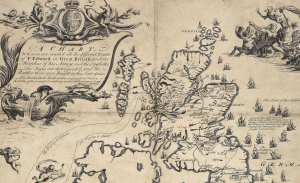
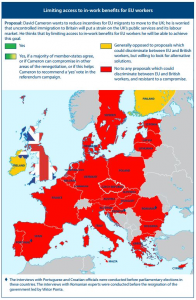
Comments - No Responses to “June 23rd Scots Book of Days”
Sure is empty down here...